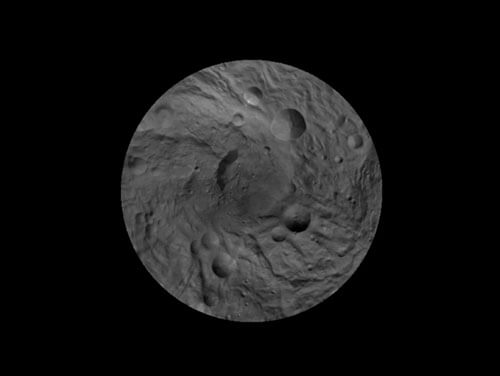The film shows impressive formations including the highest mountain in the solar system, located in the center of a huge crater

NASA has released spectacular images from DAWN's pass over the asteroid Vesta
The film shows impressive formations including the highest mountain in the solar system, located in the center of a huge crater
Map of Vesta's South Pole - This image gallery of the south pole of the asteroid Vesta was created from dozens of individual images taken by the framing camera on board the DAWN spacecraft. Photo: NASA/JPL-Caltech/UCLA/MPS/DLR/IDA
A new video taken by NASA's DAWN spacecraft orbiting the giant asteroid Vesta depicts the hover above the asteroid's surface.
The data shown in it, captured by DAWN's framing camera (framing camera) and used for visualization, will help scientists determine the processes that created the interesting formations on Vesta's surface. It will also help mission enthusiasts all over the world view the mysterious world, which is the second largest asteroid in the main asteroid belt.
The video can be viewed here.
NASA clarifies that not all of the film is lit with good lighting, for example there is no lighting in the high latitudes because, like the Earth, Busta also has seasons, and currently winter is in full swing in the Northern Hemisphere, and the North Pole region is in constant darkness. When observing Vesta from above the South Pole, half of the asteroid is in darkness, because there, like on Earth, half of the sphere is illuminated by daylight and the other half by the darkness of night.
Another interesting route in the video is a circular configuration in the South Pole area. The scientists really wanted to observe it closely since it was photographed by the Hubble Space Telescope several years ago. The diameter of the circular configuration is several hundreds of kilometers, while the height of the surrounding cliffs also reaches several kilometers. In the center of the valley, a very tall mountain rises up, 15 kilometers high - almost twice the height of Mount Everest, which makes it one of the highest formations above a solid surface in the entire solar system.
The collection of images was taken from an altitude of about 2,700 kilometers above Vesta. The photographs were taken in order to determine the axis of rotation of the asteroid and to prepare a coordinate system of the longitude and latitude lines. One of the first tasks faced by the DAWN science team was to determine the exact orientation of Vesta's spin axis relative to the celestial sphere.
The zero longitude or the main meridian of Vesta was defined by the team of researchers using a tiny crater with a diameter of 500 meters known as "Clauda" after a Roman woman who lived in the second century BC. All the craters will be named after the Vestal Virgins, the goddess Vesta, and famous Roman women while other features will be named after festivals and cities from the time.
For information on the NASA website

4 תגובות
And here is the link to the video clip:
http://www.jpl.nasa.gov/video/index.cfm?id=1020
I highly recommend going to the link given by Yaari Yossi and clicking with the mouse on the image for maximum enlargement, it looks simply spectacular!
(I think this also proves that at least this asteroid is made of Swiss cheese)
: )
And for the big picture:
http://apod.nasa.gov/apod/image/1109/vestasouthpole_dawn_3840.jpg